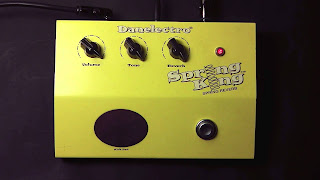The Danelectro Spring King - Spring Reverb Pedal
The pedal that puts a little spring in my step...
Rating:
A great, gritty solution for those looking for some old-school 'verb
I play in a blues/rock n roll band, which likes to intersperse classic surf guitar tunes such as Dick Dales 'Misrlou', The Lively Ones 'Surf Rider' and Jonny and Santo's 'Sleepwalk' into our set.
We play directly to P.A. and I use a pretty standard array of digital and analogue pedals, including a TC Electronic Hall of Fame for reverb duties. The Hall of Fame does what I need fine, from a short ambience to give body to my DI-ed acoustic to a reasonable hall reverb. However, as everybody knows, when you want to go surfin', you need real springs: Modern digital reverb algorithms can model real rooms and digital boxes more than well enough - but they can never quite get the trashy, metallic drip of an old-school electro-mechanical spring tank.
So I began to look at options for a spring reverb that wouldn't break the bank, or cause me to slip a disc hauling it onstage. From what I could see there were only a few contenders for this: The VanAmps Solemate (200 Euro), The Finhol Spring Reverb (159 Euro), and the cheap and cheerful Danelectro Spring King, coming in at just 108 Euro. What you would expect is that the more expensive of the three would be the best - and in a way this is true. The Solemate provides a lush and creamy reverb that will take you to places a digital reverb can, from room-sounding to full-on church.
However, this is not what I want from a spring reverb - I already have a perfectly nice digital reverb for high-quality ambience - I want something gritty and old sounding that can give me the clangy, drippy sounds of yesteryear, from Dick Dale to Link Wray to the Ventures. And that is exactly what the Spring King does.
The Spring King is essentially a short 2-spring tank, housed in a die-cast metal box, that will take up the same space as about three Boss pedals on your board. It has three knobs to control volume, reverb mix and tone, as you would expect. It also contains a gimmicky little rubber pad that you can stomp on to get the crashing sound of a drunk bassist knocking over your Fender Twin Reverb. Something about the playful pointlessness of this addition endears me to the Spring King as much as its colourful 50s mustard-yellow livery.
Sonically, this is unmistakably a spring reverb - every note has a little metallic 'sproing' to it, that sounds like a raindrop on a tin roof, surrounded by a dense bloom of dark, pillowy reflections. I even find the tone control useful here: Unlike a lot of devices where I just leave passive tone controls on ten all the time, turning the tone down makes this reverb sound even more old-school, and removing the highs can actually get the reverb 'out of the way' of the dry signal, while still providing the warmth around it.
Make no mistake - the Spring King will not replace your main reverb processor - which is precisely why its grunginess makes it shine. For nice realistic modern reverb sounds, most any modern DSP-based pedal will do you fine. For some types of old-school grit, the real thing just cant' quite be modelled. Does it sound 'better'? Well, that's a matter of opinion - some might say it sounds worse. But for my money, this is the last spring reverb pedal I'll be buying.



Comments
Post a Comment